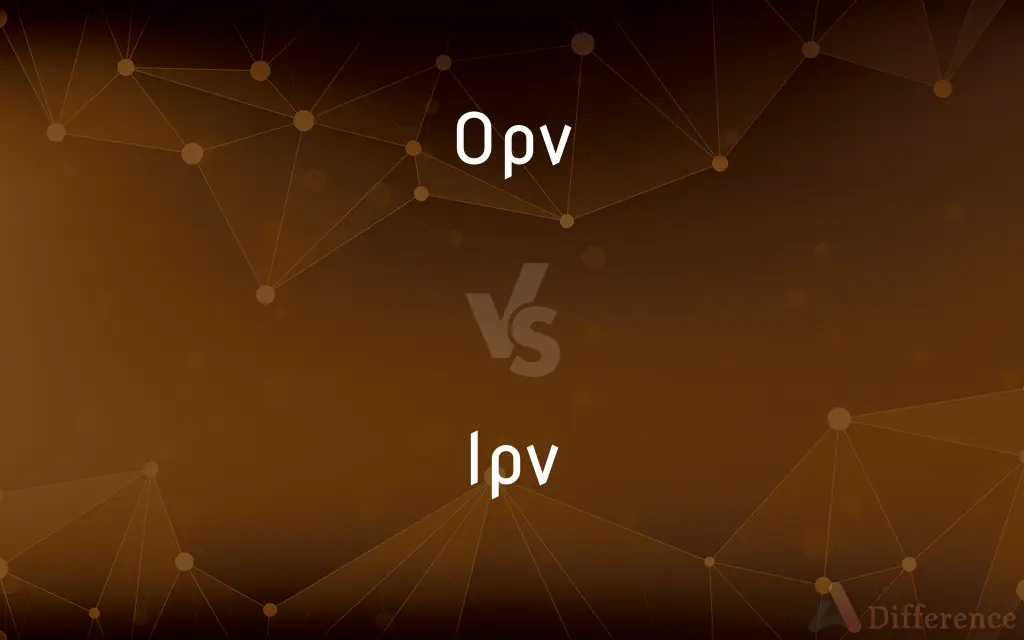OPV vs. IPV — What's the Difference?
By Tayyaba Rehman — Updated on October 30, 2023
OPV (Oral Polio Vaccine) is a live-attenuated oral vaccine for polio prevention, while IPV (Inactivated Polio Vaccine) is an inactivated injectable form. Both target the poliovirus but are administered differently.

Difference Between OPV and IPV
Table of Contents
ADVERTISEMENT
Key Differences
OPV is a live-attenuated vaccine, which means it contains a version of the live virus that has been weakened so it cannot cause disease in healthy individuals. Administered orally, it is effective and often used in mass vaccination campaigns. IPV, on the other hand, contains virus particles that are fully inactivated or, rendering them non-infectious. This inactivated form is administered through injection.
The OPV has the unique advantage of providing both individual immunity and herd immunity. When a vaccinated person excretes the vaccine virus, it can spread to others in the community, indirectly vaccinating others. IPV doesn't provide this secondary spread, but it offers a crucial benefit: zero risk of Vaccine-Associated Paralytic Poliomyelitis (VAPP), a rare side effect of OPV.
For countries with active polio transmission, OPV has historically been the vaccine of choice because of its ease of administration and ability to promote community-wide protection. In contrast, IPV is preferred in countries with no active transmission due to its safety profile and lack of risk for VAPP.
Cost and ease of administration often favor OPV. It's cheaper and can be given by volunteers during mass vaccination drives, without the need for sterile injections. IPV, while safer in some regards, requires trained health workers for administration and is generally more expensive.
Though both OPV and IPV are pivotal in the fight against polio, their usage depends on the specific circumstances and needs of a country or region. The ultimate goal, regardless of vaccine type, is the global eradication of polio.
ADVERTISEMENT
Comparison Chart
Type of Vaccine
Live-attenuated
Inactivated
Mode of Administration
Oral
Injectable
Secondary Spread
Can induce community-wide protection
No secondary spread
Risk of VAPP
Possible but rare
None
Cost and Ease of Use
Generally cheaper and easier to administer
More expensive and requires trained personnel
Compare with Definitions
Opv
Has a risk, albeit small, of VAPP
While rare, there have been cases of VAPP associated with OPV.
Ipv
No risk of VAPP
Parents often choose IPV for their children due to its safety profile.
Opv
Can lead to community-wide protection
Due to the OPV's secondary spread, even unvaccinated individuals might gain some protection.
Ipv
An inactivated vaccine against polio
IPV, being inactivated, has no risk of causing polio.
Opv
A live but weakened vaccine for polio
Many children in developing countries receive the OPV as part of mass vaccination drives.
Ipv
Doesn't provide secondary spread
Unlike OPV, IPV doesn't offer community-wide protection through secondary spread.
Opv
Administered orally
The OPV is given as oral drops, making it easy to administer.
Ipv
Given through injection
Doctors administer the IPV using a sterile syringe.
Opv
Commonly used in polio-endemic regions
Many countries with active polio transmission rely on OPV for mass immunizations.
Ipv
Preferred in non-endemic regions
Countries without active polio transmission often opt for IPV in their immunization programs.
Opv
An oral poliovirus vaccine (containing live but weakened poliovirus) that is given to provide immunity to poliomyelitis
Ipv
A poliovirus vaccine consisting of inactivated polio virus that is injected subcutaneously to provide immunity to poliomyelitis
Common Curiosities
How is IPV different from OPV in terms of administration?
IPV is administered through injection, while OPV is given orally.
Can OPV lead to polio?
While very rare, there's a risk of Vaccine-Associated Paralytic Poliomyelitis (VAPP) with OPV.
Why is IPV preferred in countries without polio transmission?
IPV has no risk of VAPP, making it a safer option where the risk of polio is low.
Which vaccine provides herd immunity?
OPV can lead to secondary spread, potentially providing herd immunity.
How many doses of OPV are generally given?
Multiple doses of OPV are typically administered for optimal immunity.
Is IPV safer than OPV?
IPV has no risk of causing polio, making it safer in terms of VAPP.
Why might a country choose OPV over IPV?
OPV is cheaper and easier to administer, especially in mass vaccination drives.
What does OPV stand for?
OPV stands for Oral Polio Vaccine.
Can OPV be given to adults?
Yes, OPV can be given to adults, especially during outbreaks or for travelers to endemic areas.
Share Your Discovery

Previous Comparison
Honey vs. Sweetie
Next Comparison
Professional vs. AcademicAuthor Spotlight
Written by
Tayyaba RehmanTayyaba Rehman is a distinguished writer, currently serving as a primary contributor to askdifference.com. As a researcher in semantics and etymology, Tayyaba's passion for the complexity of languages and their distinctions has found a perfect home on the platform. Tayyaba delves into the intricacies of language, distinguishing between commonly confused words and phrases, thereby providing clarity for readers worldwide.















































